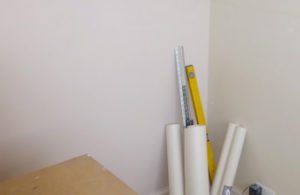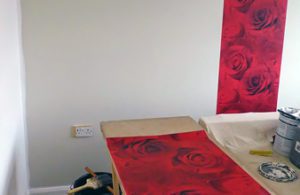I have been hanging a lot of lining paper recently and have been asked a few questions about it to so I thought this would make a good subject for some advice.
 I shall be explaining why the decorator will suggest using it or will want to use it. And no it’s not to make the job more expensive; if he’s worth his salt he will have a good reason for suggesting it. I will also tell you where it should be used and for what reason. So here goes: –
I shall be explaining why the decorator will suggest using it or will want to use it. And no it’s not to make the job more expensive; if he’s worth his salt he will have a good reason for suggesting it. I will also tell you where it should be used and for what reason. So here goes: –
Firstly what is lining paper- It is a plain paper with no finish, ivory in colour which looks like the paper you get your Fish and Chips wrapped in. As it is a preparatory paper it is designed to be used under other wallpapers or a paint finish. As such it is not to be left un-finished (as I have seen). Finish either with paints or pattern papers. If left unfinished it will quickly spoil and peel.
It comes in many grades from grade 600 to grade 1400, going up in 200’s, the higher the grade the better the paper. This represents the thickness and quality of the paper. This is plainly printed on the side of the paper. But be warned here, cheap priced papers even although calling themselves 1000 and above will be of a poor quality. Low grade papers and cheap papers will tear easily when wet, not hold back heavy cracks, get very wet when pasted making it expand a lot when drying out and will have a coarse surface which will show when painted.
Go for a good make, no lower than 1000 grade and expect to pay a reasonable price. I use Mav, Travis Perkins or Windmill lining papers, grade 1200, tried and tested over the years. DIY stores for some reason don’t sell very good quality lining papers, I think it is because they go for the very cheap priced makes. No special glues/pastes are required for lining papers, use either, a ready mixed, cellulose or starch paste, all are ok. The rule of thumb being – use the same glue/paste and thickness of paste for the lining paper as for the top finish paper. So if the top paper is a heavy-duty paper use a heavy-duty mix of glue for the lining paper also.
 Lining papers normally come in 10 metre long rolls but you can also get them in a double size roll of 20 metres, which can be useful when papering very long wall. The normal width for lining paper is 560mm or 22 inches, which is wider than normal finish wallpapers and the same width as a standard paper-hanging table.
Lining papers normally come in 10 metre long rolls but you can also get them in a double size roll of 20 metres, which can be useful when papering very long wall. The normal width for lining paper is 560mm or 22 inches, which is wider than normal finish wallpapers and the same width as a standard paper-hanging table.
So why do we use lining paper. Well let start with the easy one first – If you have walls or ceilings that are very badly cracked and keep cracking i.e. plaster board ceilings, you can hang 1 or 2 layers of lining paper over these and be pretty much guaranteed that they will not crack again. If you then paint over the lining paper with 2 or 3 coats of emulsion you will have a flush surface that looks like smooth plaster and will not crack again. In older properties the walls can be in such a poor condition that they require lining paper to literally hold them together as well as help mask or disguise the poor surface.
Lining paper is also used when a top quality-wallpapering job is required as it is the perfect surface to hang other papers over. Think of it as a bit like the undercoat of the papering world! I was always taught at college that no pattern wallpapers should ever be hung without first cross lining the walls first, but like everything these days that’s one of the first things to be left out. This is partially important when the pattern paper being used is of a thin or poor quality, as the lining paper will help reduce the finish paper from getting over wet and over expanding causing seams to pop. Will also ease the paperhanging process. It will also stop heavy cracks from breaking through its thin surface in time.
One over looked reason for the use of a lining paper is that it will add porosity or even up the porosity to a surface that has none or is irregular. Gloss, oil painted walls or surfaces that have had so many coats of emulsion will have no suction. Which will mean any top paper hung over these surfaces will have nowhere for the glue to dry out too except through the papers surface or if a vinyl just through the steams of the paper, this will cause the paper over expand on the wall making the steams pop which look unsightly. Lining paper will take a lot of this moisture away and stop this.
Lining paper is normally hung horizontally across the wall (cross lining) not vertically down the wall. This is so that in the unlikely event of the steams of the top paper coinciding with the lining paper below and is of course stronger, a bit like a piece of plywood. If being used under another paper there is no need to butt joint the edges, a 1 to 2mm gap for this is well within the acceptable tolerance.

